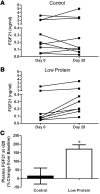FGF21 is an endocrine signal of protein restriction
- PMID: 25133427
- PMCID: PMC4153701
- DOI: 10.1172/JCI74915
FGF21 is an endocrine signal of protein restriction
Abstract
Enhanced fibroblast growth factor 21 (FGF21) production and circulation has been linked to the metabolic adaptation to starvation. Here, we demonstrated that hepatic FGF21 expression is induced by dietary protein restriction, but not energy restriction. Circulating FGF21 was increased 10-fold in mice and rats fed a low-protein (LP) diet. In these animals, liver Fgf21 expression was increased within 24 hours of reduced protein intake. In humans, circulating FGF21 levels increased dramatically following 28 days on a LP diet. LP-induced increases in FGF21 were associated with increased phosphorylation of eukaryotic initiation factor 2α (eIF2α) in the liver, and both baseline and LP-induced serum FGF21 levels were reduced in mice lacking the eIF2α kinase general control nonderepressible 2 (GCN2). Finally, while protein restriction altered food intake, energy expenditure, and body weight gain in WT mice, FGF21-deficient animals did not exhibit these changes in response to a LP diet. These and other data demonstrate that reduced protein intake underlies the increase in circulating FGF21 in response to starvation and a ketogenic diet and that FGF21 is required for behavioral and metabolic responses to protein restriction. FGF21 therefore represents an endocrine signal of protein restriction, which acts to coordinate metabolism and growth during periods of reduced protein intake.
Figures






Comment in
-
Play down protein to play up metabolism?J Clin Invest. 2014 Sep;124(9):3691-3. doi: 10.1172/JCI77508. Epub 2014 Aug 18. J Clin Invest. 2014. PMID: 25133420 Free PMC article.
References
-
- Sorensen A, Mayntz D, Raubenheimer D, Simpson SJ. Protein-leverage in mice: the geometry of macronutrient balancing and consequences for fat deposition. Obesity (Silver Spring). 2008;16(3):566–571. - PubMed
Publication types
MeSH terms
Substances
Grants and funding
- R01 DK081563/DK/NIDDK NIH HHS/United States
- P20 RR021945/RR/NCRR NIH HHS/United States
- R01 DK096311/DK/NIDDK NIH HHS/United States
- P30 DK035816/DK/NIDDK NIH HHS/United States
- P20 GM103528/GM/NIGMS NIH HHS/United States
- R01DK081563/DK/NIDDK NIH HHS/United States
- P30 GM118430/GM/NIGMS NIH HHS/United States
- P30 DK017047/DK/NIDDK NIH HHS/United States
- P20GM103528/GM/NIGMS NIH HHS/United States
- P30 DK072476/DK/NIDDK NIH HHS/United States
- R01 DK083042/DK/NIDDK NIH HHS/United States
- T32 DK064584/DK/NIDDK NIH HHS/United States
- R01 DK101997/DK/NIDDK NIH HHS/United States
- P30DK072476/DK/NIDDK NIH HHS/United States
LinkOut - more resources
Full Text Sources
Other Literature Sources
Medical
Molecular Biology Databases

